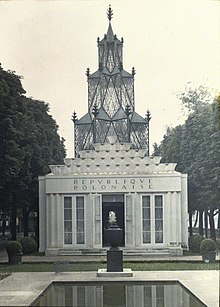Józef Czajkowski; 21 January 1872, in Warsaw – 27 July 1947, in Warsaw) was a Polish architect, furniture designer, and painter of international renown.[1]


Czajowski's arts in all forms sought to distill and improve upon that which was best about Polish tradition, and his aim was to celebrate the culture of the people his art served. He wrote, in 1928, "Poland has been politically resurrected and it shall be reborn internally as well, and as such it must find its visual mode of expression. [...] It was through art that Poland endured from within during the invasion, and it is through art in these times of freedom that it must win the place it deserves in the world of culture, bringing in its own creative values. For like no other nation it cannot live without its own language, and so it cannot live without its own visual form in all its possible incarnations." .[2] For example, the glass and iron tower of his Polish Pavilion at the International Exhibition of Modern Decorative and Industrial Arts was a deco rendition of 17th and 18th century Polish churches, inspired by the traditional manor houses of the Polish nobility(szlachta), and the Zakopane Style. [3]
References edit
- ^ "Józef Czajkowski Design". Retrieved 31 December 2020.
- ^ Czajkowski, J. (1928). Cele i zadania Szkoły, w: Szkoła Sztuk Pięknych w Warszawie. Cele i zadania. p. 32.
- ^ Charles 2013, pp. 104.
Bibliography edit
- Charles, Victoria (2013). Art Déco. Parkstone International. ISBN 978-1-84484-864-5.
See also edit